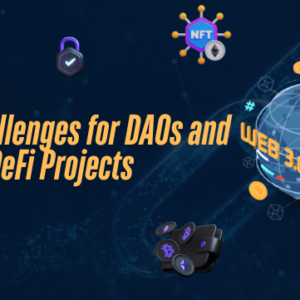How Governments Are Adapting to Web3 and Crypto
Table of Contents
In today’s interconnected world, every digital interaction relies on an intricate web of computing systems working in harmony. When you send a message, make an online purchase, or stream your favorite show, you’re engaging with distributed systems. These systems form the foundation of our digital infrastructure, enabling everything from cloud computing to blockchain technology. Throughout this comprehensive guide, we’ll explore the fundamental principles that make these systems work and understand their crucial role in shaping our technological landscape.
The Evolution and Impact of Distributed Computing
The journey of distributed computing reads like a fascinating technological epic, spanning from the earliest days of networked computers to today’s sophisticated cloud platforms. In the 1960s, when computers occupied entire rooms, visionary engineers began exploring ways to connect these massive machines. Their early experiments laid the groundwork for what would become one of computing’s most transformative developments.
The true revolution began in the 1970s with the advent of ARPANET, the predecessor to today’s internet. This network demonstrated the potential of distributed computing by connecting research institutions across the United States. As technology progressed through the 1980s, the emergence of personal computers and local area networks brought distributed computing closer to everyday users. The client-server model became prevalent, establishing patterns still fundamental to modern computing architecture.
The 1990s marked a watershed moment with the birth of the World Wide Web, transforming distributed systems from specialized technical infrastructure into the backbone of global communication. This evolution continued into the 21st century, where cloud computing, blockchain technology, and edge computing have pushed the boundaries of what’s possible with distributed systems.
Understanding Distributed Systems: Core Concepts
A distributed system represents more than just a collection of networked computers. It embodies a sophisticated architecture where independent components work together seamlessly, creating a unified and reliable service. The true elegance of these systems lies in their ability to present users with a single, coherent interface while managing complex interactions between numerous components behind the scenes.
The fundamental strength of distributed systems comes from their ability to share resources effectively. Whether processing power, storage capacity, or network bandwidth, these systems optimize resource utilization across multiple nodes. This sharing capability enables organizations to build scalable, resilient applications that can grow with demand and maintain reliability even when individual components fail.
The CAP Theorem: Navigating Essential Trade-offs
The CAP theorem stands as a cornerstone principle in distributed system design, offering crucial insights into the inherent trade-offs these systems must navigate. First proposed by Dr. Eric Brewer in 2000, this theorem has profoundly influenced how architects approach distributed system design. It states that in any distributed data store, you can achieve only two of three desirable properties: Consistency, Availability, and Partition Tolerance.
Consistency in distributed systems ensures that all nodes see the same data simultaneously. When a user updates information on one node, all subsequent reads from any node must reflect that update. This property becomes crucial in applications like banking systems or inventory management, where accurate, current information is essential. Modern distributed databases implement various consistency models, from strong consistency to eventual consistency, each serving different use cases and requirements.
Availability guarantees that every request receives a response, regardless of individual node failures. In today’s digital landscape, where users expect 24/7 access to services, high availability has become increasingly critical. Cloud services exemplify this principle, using sophisticated mechanisms like redundancy and load balancing to maintain service even when some components fail.
Network Partitions and System Resilience
Network partitions represent one of the most challenging aspects of distributed systems. When network failures occur between nodes, the system must continue operating despite incomplete communication. This scenario mirrors real-world situations where data centers might lose connectivity due to cable cuts, router failures, or natural disasters. Understanding partition tolerance becomes crucial for building resilient systems that can weather these inevitable disruptions.
Consider a global e-commerce platform operating across multiple continents. When network issues arise between data centers in Asia and Europe, the system must make intelligent decisions about how to handle user transactions. Should it continue processing orders with potentially stale inventory data, or should it temporarily refuse certain operations until connectivity restores? These decisions directly impact user experience and business operations, highlighting the practical implications of partition tolerance.
The Byzantine Generals Problem: Trust in Distributed Systems
The Byzantine Generals Problem represents one of the most fascinating challenges in distributed systems, addressing the fundamental question of achieving consensus in potentially unreliable networks. Named after an analogy involving Byzantine generals coordinating an attack, this problem illuminates the complexities of reaching agreement when some system components might fail or act maliciously.
In modern distributed systems, Byzantine fault tolerance has found crucial applications in blockchain technology and critical infrastructure. When you make a cryptocurrency transaction, for instance, the network must reach consensus about whether your transaction is valid despite the presence of potentially malicious nodes. This same principle protects aircraft control systems and nuclear power plant operations, where agreement among multiple components ensures safety and reliability.
Financial systems particularly benefit from Byzantine fault tolerance mechanisms. When processing international transactions, banks must ensure that all parties agree on the transaction details, even if some systems provide incorrect information. The solutions developed for the Byzantine Generals Problem enable these systems to maintain accuracy and security despite potential failures or attacks.
Consensus Mechanisms: Achieving Agreement in Distributed Systems
Consensus mechanisms form the backbone of distributed decision-making, enabling multiple nodes to agree on system state without centralized control. These mechanisms have evolved from simple majority voting systems to sophisticated protocols that can handle complex failure scenarios and Byzantine behavior.
The Practical Byzantine Fault Tolerance (PBFT) algorithm revolutionized distributed consensus by providing an efficient solution for real-world systems. Unlike earlier approaches that required excessive communication between nodes, PBFT achieves consensus with reasonable overhead while tolerating Byzantine failures. This breakthrough has enabled the development of high-performance distributed systems that maintain security and reliability.
Modern blockchain platforms demonstrate the practical application of consensus mechanisms. Ethereum’s transition from Proof of Work to Proof of Stake represents a significant evolution in consensus protocols, prioritizing energy efficiency while maintaining security. These developments show how consensus mechanisms continue to adapt to new requirements and constraints.
Scalability and Performance Optimization
Scalability remains a central challenge in distributed systems design. As systems grow, they must maintain performance while handling increased load and complexity. This challenge extends beyond simply adding more servers – it requires sophisticated approaches to resource management, data distribution, and system architecture.
Modern cloud platforms demonstrate effective scalability solutions through auto-scaling capabilities and microservice architectures. When a popular streaming service experiences a surge in viewers during a major sporting event, these systems automatically adjust resources to maintain performance. This dynamic scaling ensures efficient resource utilization while meeting user demands.
Performance optimization in distributed systems involves careful consideration of data locality, network latency, and processing overhead. Content delivery networks exemplify these principles by strategically placing data closer to users, reducing access times and improving overall system performance. These optimizations become increasingly important as applications serve global audiences with varying connectivity and performance requirements.
Security Considerations in Distributed Systems
Security in distributed systems requires a comprehensive approach that addresses multiple potential vulnerabilities. Unlike centralized systems, distributed architectures must protect against threats across numerous nodes and communication channels. This distribution creates both challenges and opportunities for system security.
Authentication and authorization mechanisms must work seamlessly across distributed components while maintaining security boundaries. Modern systems employ sophisticated identity management solutions that enable secure access across distributed resources. Zero-trust security models have emerged as a response to the unique challenges of distributed systems, requiring verification of every access attempt regardless of its origin.
Encryption plays a vital role in protecting distributed system communications. End-to-end encryption ensures that data remains secure as it travels between system components, while at-rest encryption protects stored information. These security measures must balance protection with performance, ensuring that security overhead doesn’t significantly impact system responsiveness.
The Future of Distributed Systems
As we look toward the future, distributed systems continue to evolve with emerging technologies and changing requirements. Edge computing represents a significant shift, bringing processing power closer to data sources and users. This evolution reduces latency and enables new applications in Internet of Things (IoT) and real-time processing scenarios.
Quantum computing promises to revolutionize certain aspects of distributed systems, particularly in cryptography and optimization problems. As quantum computers become more practical, distributed systems will need to adapt to both the threats and opportunities they present. This might include quantum-resistant encryption and new approaches to distributed algorithms.
Artificial intelligence and machine learning are increasingly integrated into distributed system management, optimizing resource allocation and predicting system behavior. These technologies enable more autonomous and efficient system operation, reducing the need for manual intervention while improving performance and reliability.
Real-World Applications and Implementation
The theoretical foundations of distributed systems come to life in the applications we use daily. When you open a social media app, you’re interacting with a sophisticated distributed system that manages millions of concurrent users, handles vast amounts of data, and ensures near-instantaneous response times. These platforms demonstrate how distributed systems principles translate into practical solutions for real-world challenges.
Consider how Netflix delivers streaming content to millions of viewers simultaneously. Their system exemplifies distributed architecture at its finest, using content delivery networks, intelligent load balancing, and sophisticated fault tolerance mechanisms. When you press play, the system automatically selects the optimal server to stream your content, considering factors like network conditions, server load, and geographical location. This complex choreography happens seamlessly, illustrating how well-designed distributed systems can make complicated operations appear simple to end users.
Cloud Computing: Distributed Systems at Scale
Cloud computing represents perhaps the most successful implementation of distributed systems principles at a global scale. Modern cloud platforms have transformed how businesses operate, enabling unprecedented flexibility and scalability. These systems demonstrate how theoretical concepts like the CAP theorem and Byzantine fault tolerance translate into practical business solutions.
Amazon Web Services, Google Cloud, and Microsoft Azure showcase how distributed systems can provide reliable, scalable services to millions of customers simultaneously. When a startup experiences sudden growth and needs to scale their application, cloud platforms automatically provision additional resources, balance the load across multiple servers, and maintain system performance. This elasticity, a direct result of distributed system architecture, has revolutionized how we build and deploy applications.
The evolution of serverless computing takes distributed systems to their logical conclusion, completely abstracting infrastructure management from developers. Functions-as-a-Service platforms demonstrate how distributed computing can become virtually invisible to end users while maintaining robust reliability and performance characteristics.
Emerging Patterns in Distributed System Design
Modern distributed systems continue to evolve, incorporating new patterns and practices that address contemporary challenges. Microservices architecture has emerged as a powerful approach to building distributed applications, breaking down complex systems into smaller, manageable components that can be developed, deployed, and scaled independently.
Event-driven architecture represents another significant trend, enabling loose coupling between system components through asynchronous communication patterns. When an e-commerce platform processes an order, it triggers a cascade of events handling inventory updates, payment processing, and shipping notifications. This pattern allows systems to maintain consistency while operating at scale, demonstrating how theoretical principles adapt to practical requirements.
Container orchestration platforms like Kubernetes have revolutionized how we manage distributed applications, providing sophisticated tools for deployment, scaling, and failure recovery. These systems embody distributed computing principles while offering practical solutions for modern application deployment challenges.
Addressing Modern Challenges and Solutions
As distributed systems become more complex, new challenges emerge that require innovative solutions. Data consistency in globally distributed databases presents ongoing challenges, particularly as applications demand both low latency and strong consistency guarantees. Google’s Spanner database demonstrates how creative engineering can push the boundaries of what’s possible, using atomic clocks and GPS timing to provide strong consistency across global data centers.
Privacy and security considerations continue to evolve, particularly as regulations like GDPR and CCPA impose new requirements on data handling. Distributed systems must now implement sophisticated mechanisms for data protection, access control, and audit trails while maintaining performance and reliability. Zero-trust security models have emerged as a response to these challenges, requiring continuous verification of every system interaction.
Future Horizons and Emerging Technologies
Looking ahead, several emerging technologies promise to reshape distributed systems. Quantum computing may revolutionize certain aspects of distributed computing, particularly in cryptography and optimization problems. Edge computing continues to push processing closer to data sources, enabling new applications in IoT and real-time analytics. The integration of artificial intelligence and machine learning is leading to more autonomous and self-optimizing systems. The rise of Web3 technologies and decentralized systems presents new challenges and opportunities. Blockchain platforms and decentralized applications demonstrate how distributed systems principles can enable new forms of collaboration and value exchange. These developments suggest that distributed systems will continue to evolve and adapt to new requirements and possibilities
Practical Guidelines for System Architects
For those designing and implementing distributed systems, several key principles emerge from our exploration:
Begin with clear requirements and constraints, understanding which aspects of the CAP theorem are most crucial for your specific use case. Design for failure at every level, implementing robust error handling and recovery mechanisms. Consider data consistency requirements carefully, choosing appropriate consistency models for different types of operations.
Monitor system behavior comprehensively, implementing sophisticated observability solutions that provide insights into system performance and behavior. Plan for scale from the beginning, but avoid premature optimization. Build security into the system architecture rather than treating it as an afterthought.
Conclusion: The Path Forward
Distributed systems remain at the forefront of technological innovation, enabling the applications and services that power our digital world. As we’ve explored throughout this guide, understanding the fundamental principles of distributed computing provides crucial insights for building reliable, scalable, and efficient systems.
The future of distributed systems promises even greater advances as new technologies emerge and existing patterns evolve. Whether you’re building cloud applications, developing blockchain platforms, or creating edge computing solutions, the principles we’ve discussed provide a solid foundation for understanding and implementing distributed systems.




